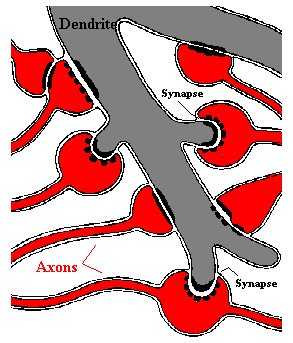 |
Prions in Long-Term Memory |  |
 |
Prions in Long-Term Memory |  |
 By Melissa Lee Phillips
By Melissa Lee Phillips Neuroscience for Kids Consultant May 18, 2004 The type of protein that has made a bad name for itself with mad cow disease may yet be redeemed. A protein similar to the infectious prion protein that causes mad cow -- and its human form, variant Creutzfeld-Jacob disease -- might be part of the intricate neural mechanism for long-term memory, says a group of researchers led by Kausik Si of Columbia University in New York City. A prion's characteristic qualities, namely that it is long-lasting and self-perpetuating, could make it an ideal molecule to help store a long-term memory. A persistent problem in the study of memory is how molecules in the brain can "remember" a memory for years, even a lifetime. How it is that our brain's cells can permanently store information that we learn?
Si and his co-workers found that a protein called CPEB (cytoplasmic polyadenylation element binding protein) was involved in memory formation in the sea slug Aplysia. Other researchers had implicated CPEB in memory formation before. The scientists found that when they stimulated a neuron -- like it might be stimulated when the animal perceives something -- CPEB proteins were activated. In their active form, they promoted the expression of several proteins that establish new synaptic connections, and thus, assist the brain in storing a long-term memory.
To test to see if this CPEB protein did indeed behavior like a prion, the researchers inserted the Aplysia CPEB protein into yeast cells (because direct observations are easier in simple organisms such as yeast than in animals such as Aplysia), and looked for prion-like behavior. What they found confirmed their hunch: CPEB proteins developed into two different forms, a regular protein and a misshapen one. Typical of prion behavior, when a normally shaped CPEB protein encountered a prion counterpart, it too turned into a prion. Unlike the prion of mad cow and Creutzfeldt-Jakob diseases, the CPEB prion is not toxic to the cells it inhabits. And unlike almost all other misfolded proteins, the prion version of CPEB is functional: it activates synaptic growth molecules just like the regular protein is supposed to. In fact, the prion protein is even better at this job than the regular protein is.
Thomas J. Carew, a neurobiologist at the University of California, Irvine, who also studies memory in Aplysia, thinks that "the prion story is highly creative and potentially extremely important." But he adds that much more work needs to be done to confirm the CPEB prion's possible role in long-term memory. The studies' scientists agree, acknowledging that they have only shown directly that CPEB behaves like a prion in yeast, not in neurons. And even if these prion properties hold up in Aplysia neurons, it is not known if mammalian forms of the protein will behave in the same way. |
|
References and Other Resources:
|
| GO TO: | Neuroscience In The News | Explore the Nervous System | Table of Contents |
![[email]](./gif/menue.gif) Send E-mail |
 Fill out survey |
 Get Newsletter |
 Search Pages |
 Take Notes |